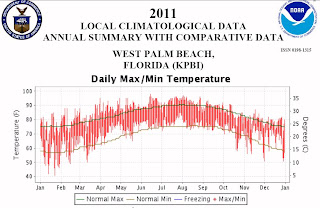I'm in Florida, and the floor was warm this morning to my bare feet.. Not surprising you may say. But usually a concrete floor appears relatively cool to us, since it takes away some of the body heat. The rest of the house is raised up with a crawl space, and we had a pretty cool night. So the wooden floors were cooler, but when I went down into the part that used to be a garage and is slab on grade, that's when the floor seemed relatively warmer. It was warmer because the weather has been hotter and then turned cooler, and the ground and the floor is slow to change; but ti made me think about the whole subject of thermal mass and the ground temperature
We sometimes see blanket statements like "the ground temperature is at 60 degrees", which is approximately true for much of the United States - but in fact it depends where you are talking about. Specifically, the ground temperature more than six feet from the surface is constant, and is the same as the average annual temperature for that location. Down here in South Florida we have an average temperature of around 75 degrees, and that is the deep ground temperature. You can see the whole range of annual temperatures from the picture, which is the daily temperature graph for West Palm Beach in 2011.
These excellent sources of climate data are now available free from http://www.ncdc.noaa.gov/oa/mpp/ , it's a great tool for checking heating and cooling strategies for a location. From this graph, for example, we can see that for much of the Summer not much relief is available from nightime cooling, since temperatures do not go below 70 deg.
The logic of sustainability. A site about preparing for a future where humankind intends to be on this planet for the long term. About a future - a near future - where the developed world will have to consume less and share more.
Tuesday, April 24, 2012
Friday, March 16, 2012
Climate Saving Time
Along with the change to and from Daylight Saving time twice every year, I propose Climate Savings Time. The purpose behind this is acclimation - to encourage our bodies to welcome a different range of temperature. In three weeks it is possible to adjust to different ambient temperatures, within reason. Thus during the Winter in the colder regions - probably the northern two thirds of the US, at least - we might be comfortable at a temperature around 70 degrees F. Depending on the building, amount of clothing, our activity level and so on, we might tolerate temperatures from 65 to 75 degrees. Once the hot weather rolls around we throw off extra clothing, and turn the thermostat up a bit - but not very much, generally. I notice that people still expect temperatures around 74- 78 degrees, or less - considerably less it seems in cinemas and supermarkets. We could definitely save a good deal of energy if we did not have to cool our buildings to the same extent. We can adjust to a wider range of temperatures. Part of it is mental willingness to put up with a wider range of physical comfort, at least in the short term. But our bodies and their perceptions can rapidly adjust to a new norm; three weeks is what I am suggesting, based on research done in the past.
So for all regions where there is a switch from a heating to a cooling season, I suggest a three week "Climate
Saving" changeover. Right after the introduction of Daylight Saving Time will work fine for most areas, I think.
So to switch from a winter setting of 68 to a summer setting of 78, we are only changing by 10 degrees in 21 days. Thus altering the thermostat settings by one degree every two days would do it, and should not be too great a shock to the system.
Comfort at higher temperatures depends to quite an extent on humidity, as well on air speed (as air passes over our skin it encourages evaporation and makes us cooler). So one of the important things air conditioning does is to reduce humidity. The whole question of temperature and humidity settings, perceived comfort, and energy savings, is thus a bit more complex, and I'll deal with it in more detail in other postings.
So for all regions where there is a switch from a heating to a cooling season, I suggest a three week "Climate
Saving" changeover. Right after the introduction of Daylight Saving Time will work fine for most areas, I think.
So to switch from a winter setting of 68 to a summer setting of 78, we are only changing by 10 degrees in 21 days. Thus altering the thermostat settings by one degree every two days would do it, and should not be too great a shock to the system.
Comfort at higher temperatures depends to quite an extent on humidity, as well on air speed (as air passes over our skin it encourages evaporation and makes us cooler). So one of the important things air conditioning does is to reduce humidity. The whole question of temperature and humidity settings, perceived comfort, and energy savings, is thus a bit more complex, and I'll deal with it in more detail in other postings.
Subscribe to:
Comments (Atom)
